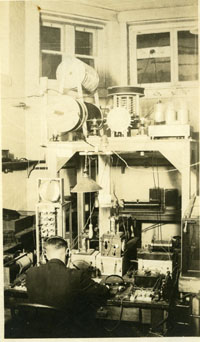
While Detroit (WWJ), Pittsburgh (KDKA), and San Francisco (KQW) all make claim to having the oldest continually operating radio station in the United States, WHA was experimenting with the medium as early as 1909 (and possibly as early as 1902), with Edward Bennett in the Physics Department sending radio signals across Sterling Hall. WHA is distinguished from other early radio experiments by two factors: 1) The can-do attitude and self-sufficiency of its early radio theorists and technicians, epitomized by Earle M. Terry, and 2) Its standing dedication to non-profit, university extension programming. WHA remains the longest running educational station in U.S. history, as well as the best example of alternate programming to the standard ubiquitous commercial model still in practice today.
The story of WHA is a story of its founders, managers, and staff—a motivated and wily group who succeeded in developing the medium through collaboration, trial and error, hard work, and especially in the earliest days, some luck.
Between 1915 and 1920 Earle M.Terry and his graduate students literally built the 9XM radio transmitter from the ground up in the labs of the University of Wisconsin’s Physics department. When they were able to broadcast with some consistency, they soon realized radio’s potential for the exchange of information and the spread of education. Charles Van Hise’s “Wisconsin Idea,” that the university’s services should be available to every resident of the state, served as a motivating force behind station philosophy, leading WHA to initially utilize 9XM as a public service for weather, agricultural, and market news.

During World War I, 9XM was one of a very few stations allowed to continue experimental broadcasting because of its affiliation with the Great Lakes Naval Academy, which led to its advancement in technical prowess while other stations were forced to remain dormant. In the 1930s a second generation of broadcasters came up who seized upon the “Wisconsin Idea” and combined it with the influence of progressivism and pragmatism. They took the already solid philosophical foundation of radio as an educational medium and built a curriculum around the ideals and practices of the station—a curriculum that included not only university extension broadcasting from professors, but a talented group of radio professionals who educated schoolchildren as well as adults, and offered actual radio courses for credit.
Photographs
Digital Documents
Capital Times article covering 9XM plaque
Related Links
